Puerto Rican Pernil (Roasted Pork Shoulder) is a garlicky, succulent entree that is a must at celebrations, holiday dinners, and- for me- supper whenever I crave it. The most beloved part of the pernil, besides the aromatic, tender meat is the chicharrón or cuero. You might know it as pork rind or crackling. We could call it heaven and not be too far off. The crispy cuero (skin) is one of the many rewards for making this pernil.
This is holiday food. Pernil is the food that, when you smell it roasting in your home, you know something’s about to go down. I make it for any special occasion…even if that occasion is called “Wednesday night”. My family doesn’t stand for formality. We’re a simple tribe.
**This post has been updated with sparkly new images and more concise instructions**
What is Pernil? What’s the difference between it and Lechon?
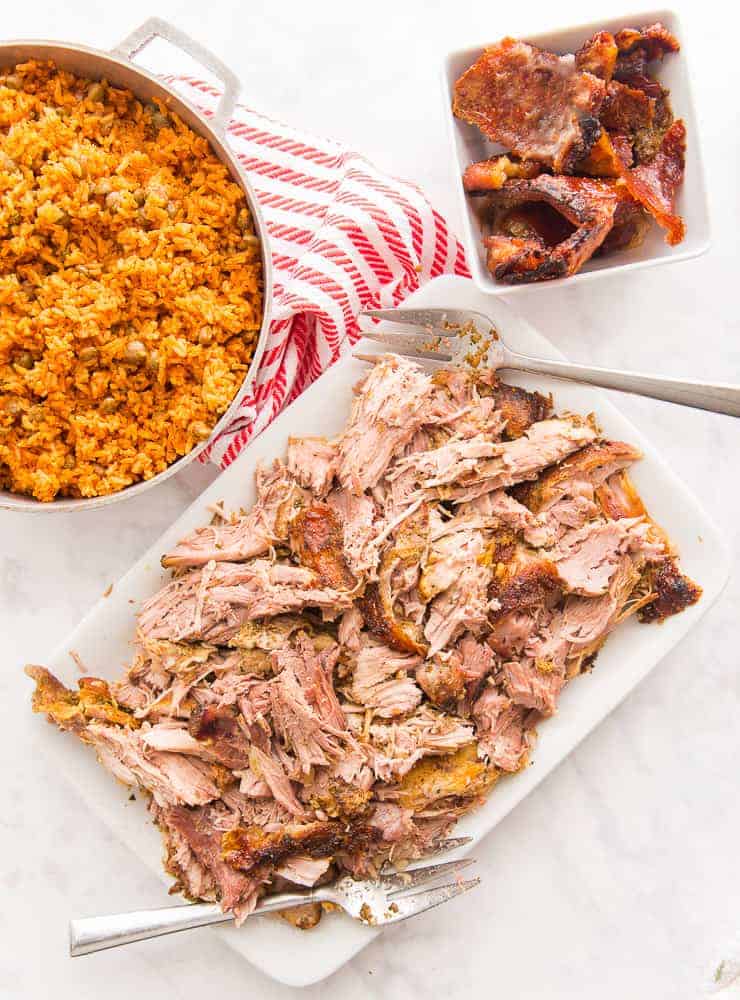
For starters, pernil is the shoulder picnic cut of the pig. To make a traditional pernil, it must be bone-in and skin on. Don’t go getting all froufrou talking about, “I want boneless, skinless.” You’ll be “chicharron-less” and flavorless and you won’t be happy with yourself. The joy of life is crunching down on a crispy piece of the skin and eyeballing anyone who dares trifle with your portion. Ask Hector’s buddy. He had a flesh wound, y’all. A pernil is flavored with tons of garlic and a sofrito paste before marinating for at least 2 days. It’s roasted to a crispy, juicy perfection and that’s that.
A lechon is a whole pig roasted over a spit. They’re seasoned the same way, however, one induces more guilt than the other. Not for me, mind you. I’m good looking at a pig’s head while I eat it’s ribs.
What cut of meat is pernil?
When you look for your pernil, seek out pork shoulder. You want a bone-in, skin-on pork shoulder that’s at least 10 pounds. Leftover pernil is a must, my friend. If you can’t track down a pork shoulder, look for a Boston Butt. Same deal: bone-in, skin-on. Because both, the shoulder and the butt, are tough cuts of meat, we roast our pernil slowly. Those areas on a pig put in work during its life, so they’re very tough. Between the extended marinating and the long roast, you will end up with a pernil that can be pulled apart.
What do I need to make a roast pork shoulder?
I’m very simple in the way I season my pernil. It’s my method that’s less than traditional. But, in order to get to the untraditional method I use, we need to start with our shopping list.
For starters: our spice paste is made with a TON of fresh garlic. Like, 2 big heads. Use tons of garlic because that’s the most prominent flavor in a traditional pernil. When I tell you you can smell a pernil being roasted from outside, I’m not exaggerating. It’s intensely seductive. Onion powder is the next ingredient in my spice paste. Loads of it as well. I don’t use fresh onion, because it’s hard to get a smooth paste. The chunks of onion will char on the outside of the pernil which doesn’t taste good. Finishing the spice paste is sazón, adobo, dried oregano leaves and black pepper. Sazón is a flavoring and coloring ingredient which is widely popular in Puerto Rican cuisine, as is adobo. Feel free to use store-bought or homemade versions of those two.
The roasting takes place in two roasting pans, preferably in one with a rack, the second one can be rackless. I recommend using the disposable roasting pans since you need two for optimal results.
After mashing the garlic to smithereens and mixing in the spices, I add a bit of sofrito. Sofrito is an herb cooking base which is made from a blend of culantro, onions, garlic, and sweet peppers. Learn more about sofrito here , but suffice to say, this stuff will change your life. Spoon it into the spice rub and mix well in the same vessel you mashed your garlic with. You can see I use a wooden mortar and pestle. A food processor or blender also works. If you don’t have either, crush the garlic and combine everything with a spoon, instead.
How do I get a crispy skin (chicharrón) on my pernil?
Here’s where I begin going rogue. I don’t know when, or how, I decided to start separating the top fat layer from the meat of the pork shoulder, but I did and things have never been the same. The first step in achieving that coveted pork crackling on your pernil is to partially separate it from the meat itself. I going to show you how.
Grab a firm hold on the top layer of the skin and, carefully, run your knife’s blade along the line where the fat and skin meet. Use a very sharp boning knife for this, if you have one. If not, your chef knife is fine. If you have a properly sharpened knife, it should go through like butter. Don’t cut the skin all the way off! Just make a cut between the fat and the meat, leaving the back and sides of the skin attached. Basically, you’re making a pocket. Work slowly, cutting away the skin and fat layers from the meaty, dark pink flesh. If you accidentally separate the skin completely, it’s okay, you’ll just have to lay it back on after seasoning.
After you create the pocket, pull the skin back a little and pierce slits into the flesh using the tip of your knife. These slits help the seasoning penetrate the meat while it’s marinating. Be careful not to puncture the skin, though! We want it to be as intact as possible prior to roasting. Flip the roast over and make slits in the bottom of it as well.
Do I need to wash my pernil before cooking?
Yes, but not in the way you think.
Both my Black and Latin cultures are used to washing their meat under cold running water prior to cooking. I no longer do that because I’ve been brainwashed by my time in the kitchen. That said, feel free to rinse your meat if that’s how you learned.
When it comes to the pernil, however, you need to “wash” the meat once again with white distilled vinegar. The vinegar’s acid multitasks as a flavoring agent, bacteria and smell killer, as well as a tenderizer. It breaks down the connective tissue in the, otherwise, tough shoulder.
Transfer your pernil to a large bowl (or leave it in the sink if you washed it) and douse it in the vinegar. Rub the vinegar outside the piece of meat, inside the pocket and on the skin. Now you can season it.
How do I season pernil?
Take your flavoring paste and shove a big spoonful of it in that cavity you made between the skin and flesh. Now, rub it into the meat: make sure to press the paste into those slits in the meat under the skin. Now, flip the pork over and rub the bottom side with another heaping spoon of spice paste. Flip it back over and rub the remaining spice paste onto the the skin. If you don’t have a lot of paste leftover, that’s okay. You don’t want too much paste on the skin when we go to roast it anyway.
How long do I marinate a pernil?
Unconventional step numbers two and three: I marinate my pork for three days and I force flavor into it. By “forcing flavor into it”, I mean I trap the spices so that the only place they can go is into the meat. Remember those slits we cut into the meat? This is why we did it.
Let me explain how we force this flavor into the meat: lay out a sheet of heavy duty aluminum foil, and then lay out three sheets of plastic film. Put the seasoned pork in the center of the wrapping film and I wrap it tightly in the plastic first. So tightly, in fact, that my muscular forearm is quite impressive when I do it, is it not?
Stop rolling your eyes.
Swaddled like a little pork cherub. I’m convinced heaven will have pernil. Now, seal it tightly in the foil and let it marinate in the fridge for at least 2 days, but 3 days if you can. The least amount of time I’ve marinated a pernil was a day, though. It still had an amazing flavor because of the forced flavoring.
Do I roast my pernil covered or uncovered?
Once you’re ready to roast, unwrap it and put it on a roasting rack inside of a roasting pan. The rack keeps the pernil from boiling in its juices. Pat the pernil skin down with a paper towel to dry it and remove the spice paste. It tends to char if left on during roasting. Begin heating your oven to 350°F, and leave the pork to sit on the countertop for at least 30 minutes to an hour to warm up. A cold pernil takes longer to begin roasting than a semi-warm one does.
I used to recommend covering the pernil for the majority of the cooking time, but soon realized many people were losing their cuero to the foil. Once the collagen in the skin starts to melt, it causes the foil to stick to it. That usually results in the foil snatching part of the skin with it when you remove it. So, let’s scrap the foil covering so you can have beautiful skin.
How long do I cook a pernil?
Here’s a tip: roast your pernil at 350°F for 35 minutes per pound for the majority of the cooking time. A 10-pounder will roast for a total of 5 1/2-6 hours. Calculate # of pounds x 35 = x /60 and you’ll have your cooking time- round up to the next quarter of an hour if need be. So:
5 pound pernil= 3 hours roasting time
7 pound= 4 hours
8 pound= 5 hours
9 pound= 5 hours 15 minutes
10 pound= 6 hours
How to get that crispy skin on a pernil
An hour before your total cooking time is up, remove the pernil from the oven. Increase the oven temperature to 425°F. If you have a separate roasting pan (disposable is awesome for this), carefully transfer the pernil to it. It’s best to move the pernil from the pan with all of the drippings. The drippings are nothing but grease, which tends to start smoking in the hotter oven. Once you transfer the pernil to the clean roasting pan, use a brush to brush a thin layer of the pan juices onto the skin. Sprinkle a 1/2 teaspoon of kosher salt onto the greased skin. This will draw up any excess moisture in the skin.
Once the oven reaches temperature, put the pernil back in and finish roasting. Roast the pernil until the skin sounds hard when tapped. The edges may become a bit dark, but the center of the skin should remain a brick-red color. Turn the pan every 15 minutes while you’re crisping the cuero. This vents the steam that builds up in the oven and keeps the skin from crisping up. It also prevents one side from going to dark. The skin will begin to blister and pop and angels will sing.
How do I know when my pernil is done cooking?
Your pernil should have an internal temperature of between 180-200°F when it’s properly roasted.
The juices of the pernil will run clear with no blood, as well.
Remove it from the oven and allow it to cool for at least 30 minutes in order to allow the internal juices to settle down.
Can I smoke a pernil?
Yes, you can totally smoke this pernil in a smoker for 14 hours, but you won’t be left with the amazing crunchy chicharrón. Don’t you want to be able to lift a whole slab of a pork rind from your pernil? No, but if you want to smoke it, go for it. My buddy Derek used this recipe for his smoked pernil and said, with the exception of the missing chicharrón, it was amazing.
What other ways can a pork shoulder be cooked?
If you have a rotisserie machine, a pernil would be great cooked in it. You may need a smaller roast to fit in the machine, but it would be similar to roasting a lechon. Just season as normal and follow the machine’s instructions for roasting in it.
How do I store leftovers? Does pernil freeze well?
After allowing the pernil to rest a few minutes, remove the chicharrón and shred the meat from the bone. As you can see, I only need a carving fork to do that. Serve the pernil while hot.
Any leftovers should be transferred to a food storage container and kept in the fridge for 3 days. To reheat the meat, just flick a little water over it and microwave it until warmed through.
Can you freeze pernil?
You most certainly can! I actually make a larger pernil for the purpose of freezing half of it for later. The chicharrón is the only thing that doesn’t keep past the day it’s made, so enjoy that heartily.
Pop the shredded pernil into a freezer storage bag and freeze for 6 months. Thaw in the fridge when you’re ready to eat and reheat as instructed above.
Just one taste of this Puerto Rican Pernil and you’ll see why my husband almost caught a case over it. Be sure to pin it to all your boards and share it with your friends! If you make it, be sure to tag me on IG or FB: @senseandedibility or on Twitter or Pinterest: @ediblesense!
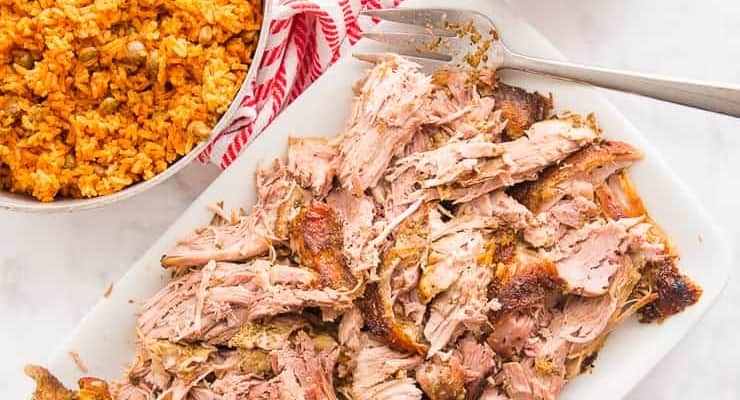
Pernil (Puerto Rican style Roast Pork Shoulder)
at Sense & EdibilityEquipment
- 2 Roasting pans (one with an inner rack)
Ingredients
- 10 pound pork shoulder bone-in, skin-on
- 1/4 cup white vinegar
- 16 cloves garlic (or 2 heads) peeled and mashed to a paste
- 2 tablespoons Sofrito
- 2 tablespoons Adobo seasoning
- 2 tablespoons onion powder
- 1 1/2 tablespoons sazón
- 1 1/2 tablespoons dried oregano leaves
- 1/2 tablespoon kosher salt plus more for seasoning prior to roasting
- 1 1/2 teaspoons black pepper
Instructions
Prep the Pork Shoulder
- Grab a firm hold on the top layer of the skin and, carefully, run your knife's blade along the line where the fat and skin meet. Use a very sharp boning knife to cut between the fat and the meat, leaving the back and sides of the skin attached- creating a pocket.
- After you create the pocket, pull the skin back a little and pierce slits into the flesh using the tip of your knife, taking care not to puncture the skin in the process. Flip the roast over and make slits in the bottom of it as well.
"Wash", then Season the Meat
- Transfer your pernil to a large bowl (or leave it in the sink if you washed it) and pour the white vinegar outside the piece of meat, inside the pocket and on the skin. Rub the vinegar into the meat well.
- In a bowl, combine the mashed garlic, sofrito, adobo, onion powder, sazón, oregano, salt, and pepper to create a thick paste.Use a large spoon to scoop a third of the paste into the cavity you created between the skin and flesh. Massage the rub it into the meat: make sure to press the paste into those slits in the meat under the skin.
- Flip the pork over and rub the bottom side with another third of the spice paste. Flip it back over and rub the remaining spice paste onto the the skin.
Wrap and Marinate the Pernil
- Lay out a large piece of heavy duty aluminum foil (or enough sheets to completely wrap the pernil). Over the foil, lay out three sheets of plastic wrap. Put the seasoned pork shoulder in the center of the wrapping film and wrap it tightly in the plastic first, then wrap it tightly in the foil.
- Set the wrapped pork on a sheetpan and and let it marinate in the fridge for at least 2 days, but 3 days is best. You can roast the pernil in as little as 12 hours, but it won't be as flavorful.
Roast the Pernil
- When you're ready to roast, unwrap the pernil and put it on a roasting rack inside of a roasting pan. Pat the pernil skin down with a paper towel to dry it and remove the spice paste. Leave the pork to sit on the countertop for at least 30 minutes to an hour to warm up. A cold pernil takes longer to begin roasting than a semi-warm one does. Position the middle oven rack down one notch so it is in the lower third of the oven. Preheat your oven to 350°F,
- Roast the pernil at 350°F for 5 hours.
- When the roasting time is up, remove the roasting pan from the oven. Increase the oven temperature to 425°F.
- Season the outside of the pernil with a light sprinkling of kosher salt (about 1/2 teaspoon). Carefully, transfer the pernil to a clean, disposable roasting pan.Once the oven reaches temperature, put the pernil back in and finish roasting for up to 1 hour. Turn the pan every 15 minutes to vent the steam that builds up and to crisp up the skin evenly. The skin will begin to blister, harden, and sizzle. Once the pernil skin sounds hard when tapped with the back of a knife, remove it from the oven. This may happen before the hour is up.
- The fully cooked pernil should have an internal temperature of between 180-200°F. The juices of the pernil will run clear with no blood, as well. Remove it from the oven and allow it to cool for at least 30 minutes in order to allow the internal juices to settle down.
- After allowing the pernil to rest a few minutes, remove the chicharrón and shred the meat from the bone. Serve the pernil while hot.
Notes
Tips and Techniques:
- Finishing the pernil in a clean roasting pan eliminates the smokiness produced by the grease in the first pan.
Pernil Roasting Times:
5 pound pernil= 3 hours roasting time
7 pound= 4 hours
8 pound= 5 hours
9 pound= 5 hours 15 minutes
10 pound= 6 hours
Smoking Instructions:
- Follow instructions as directed.
- Smoke the pernil with your preferred wood at 250°F for 15 hours.
- You won't be left with the amazing crunchy chicharrón with this method, so remove the skin or chop it up and mix it in with the pulled pork.

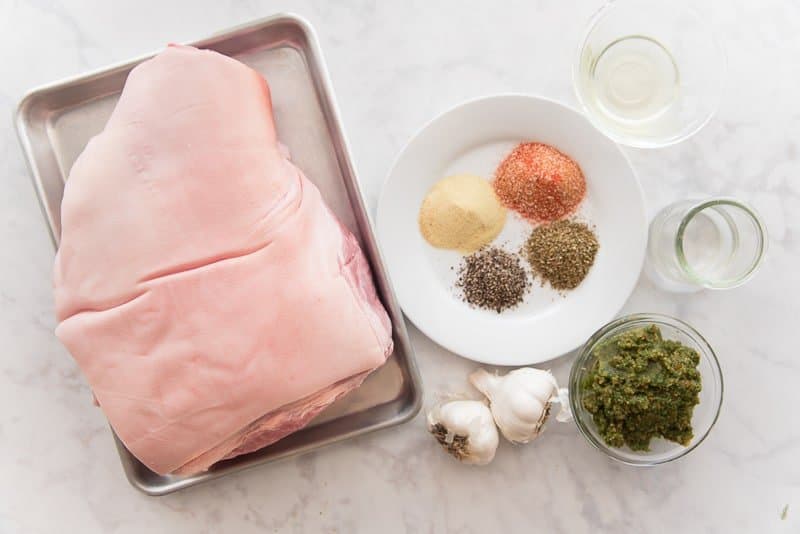
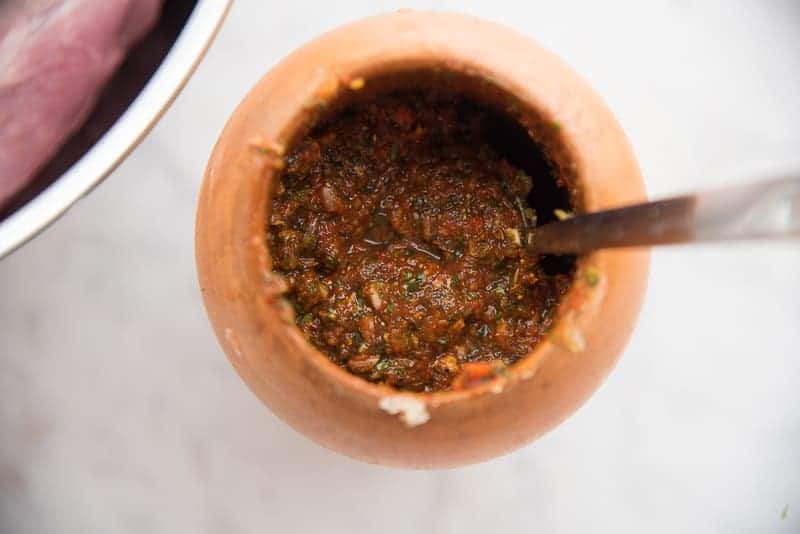
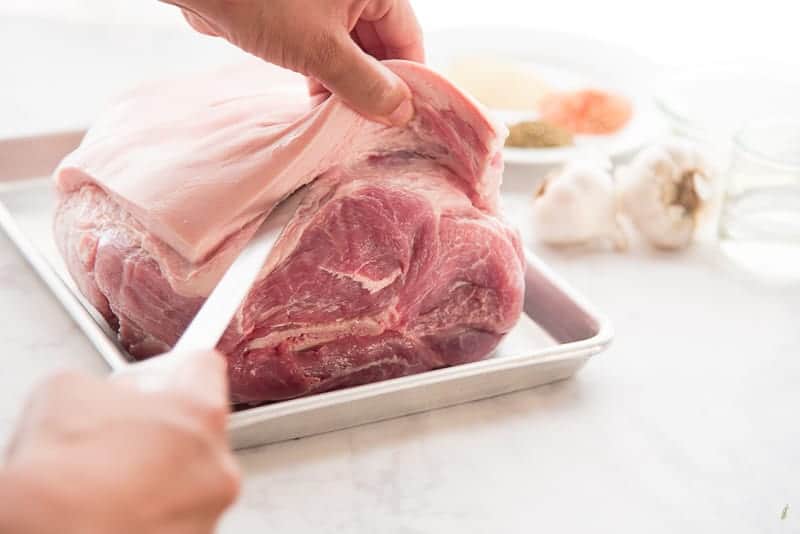
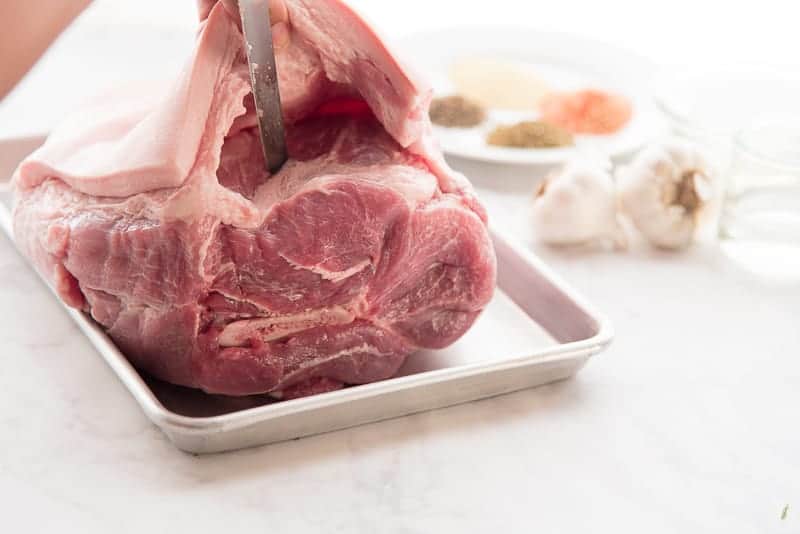
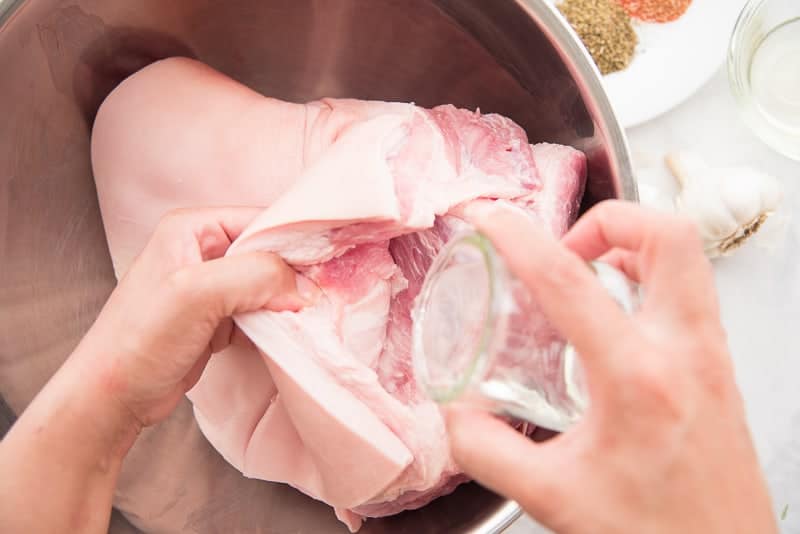


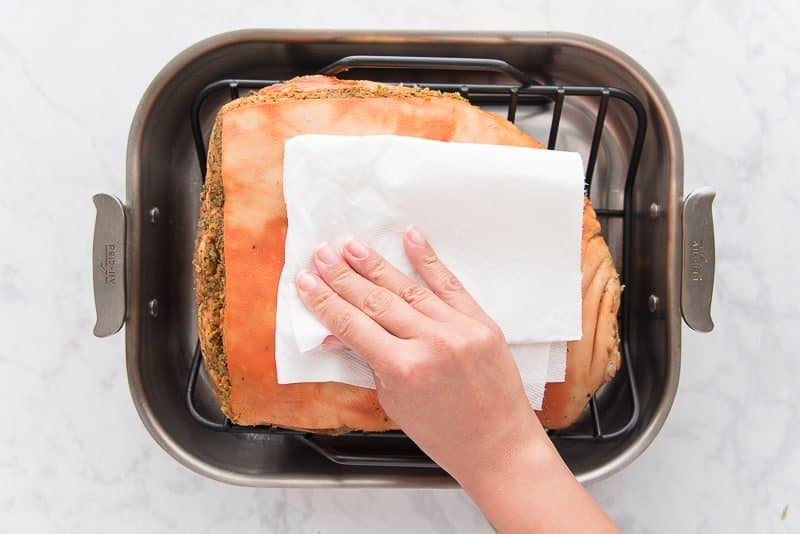
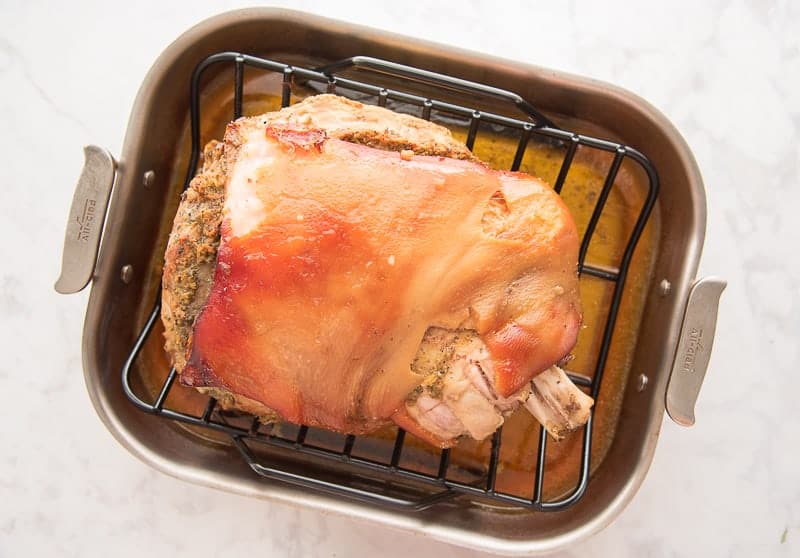
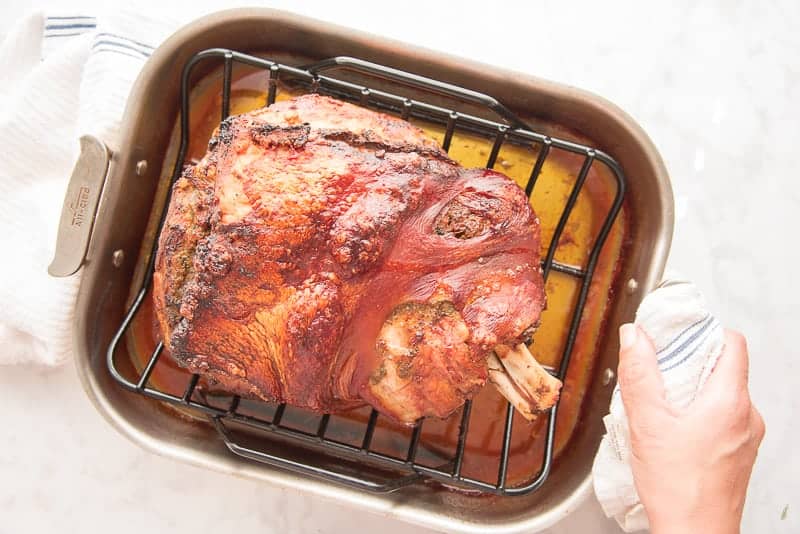
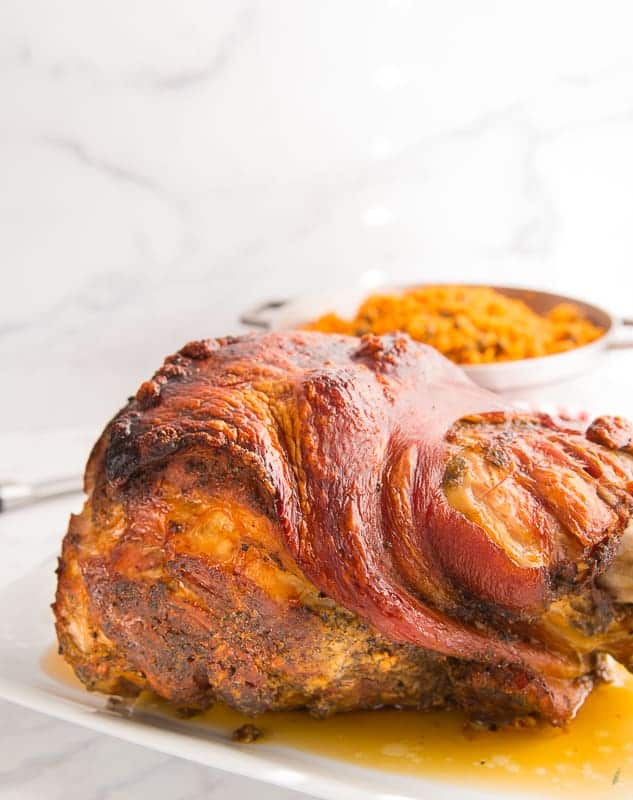
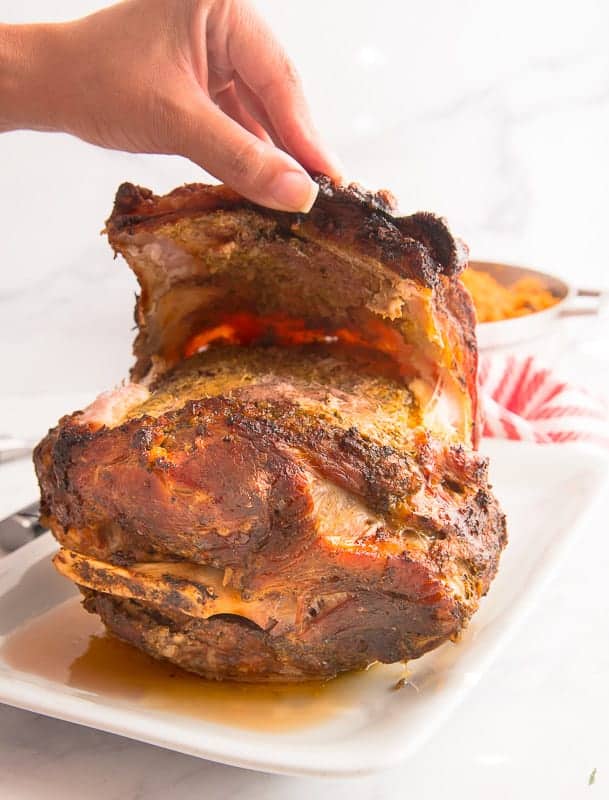
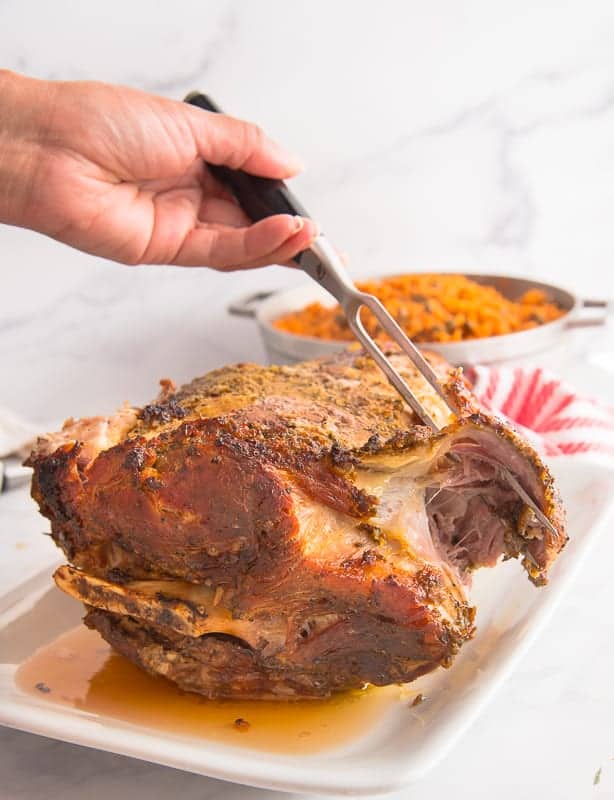
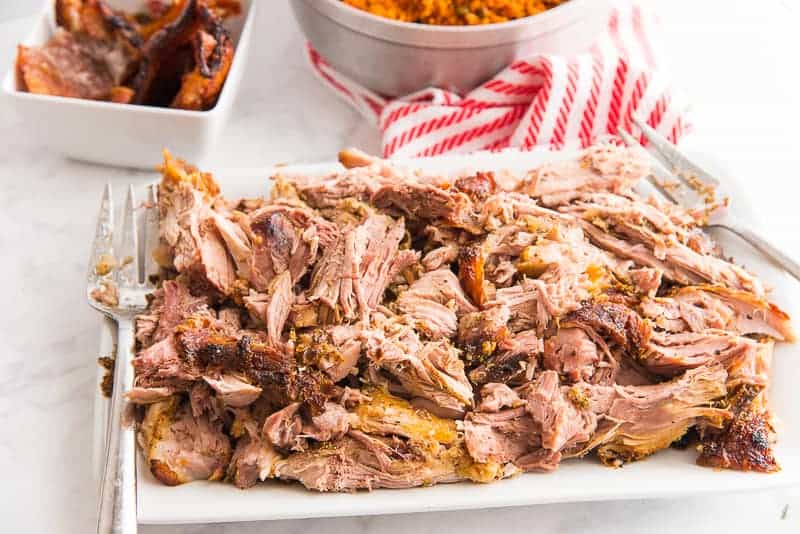
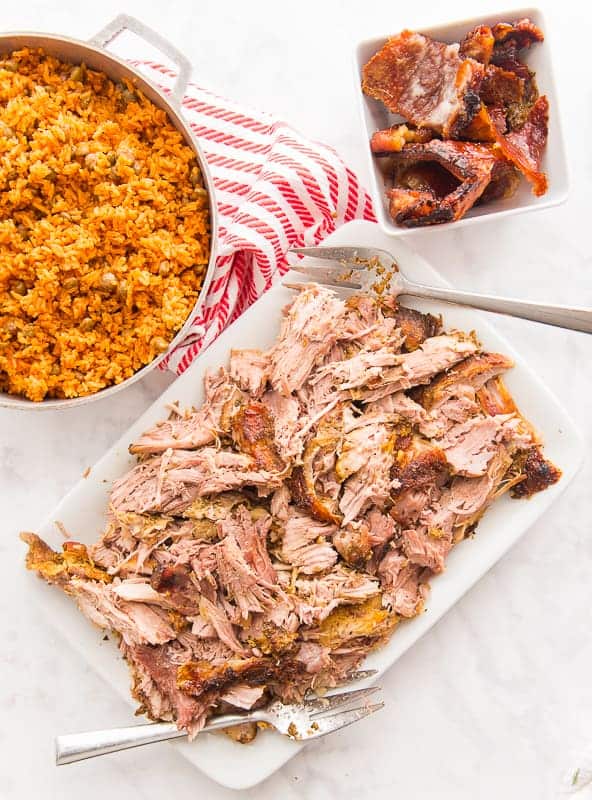

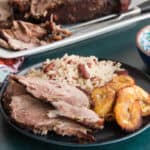
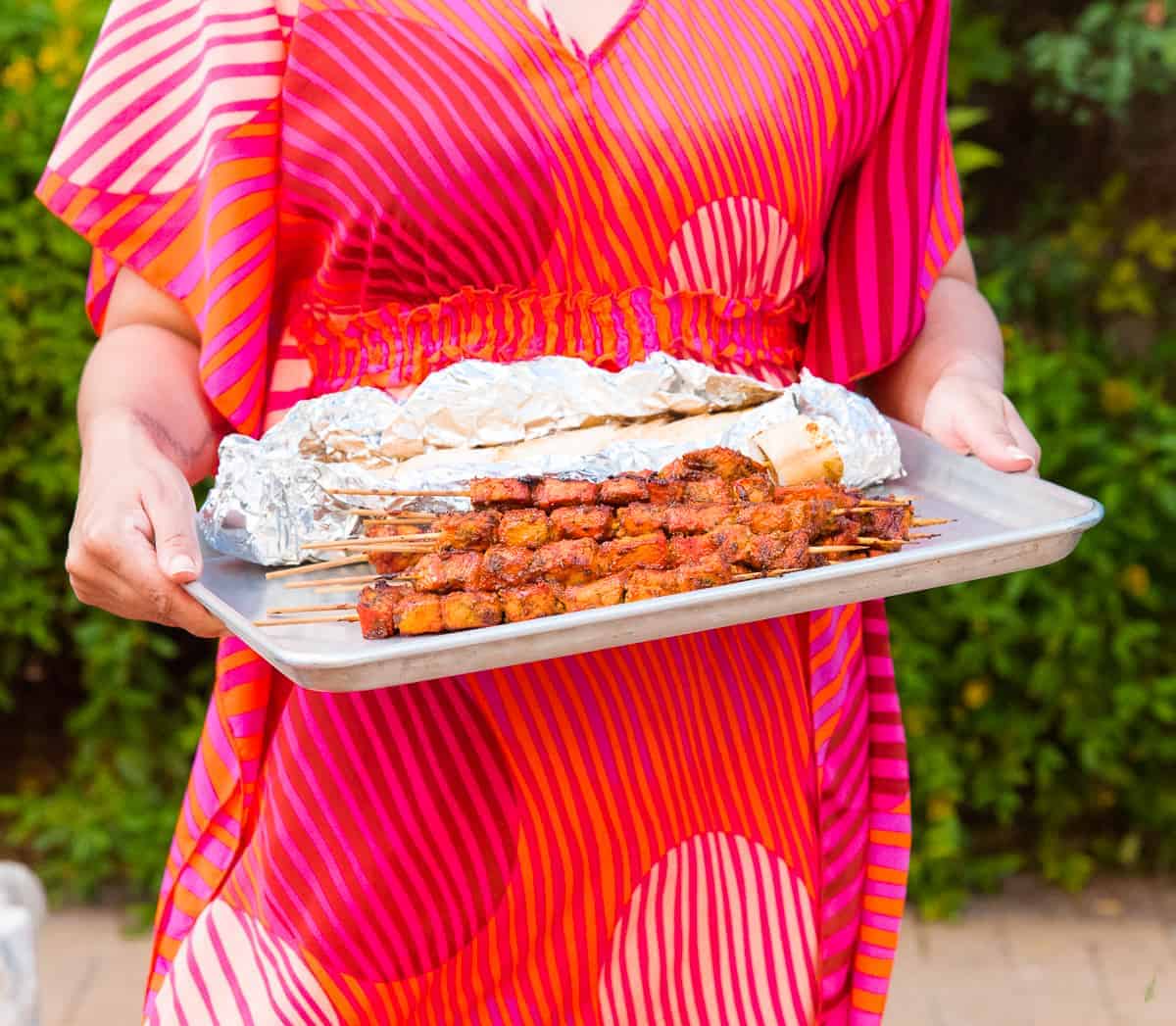

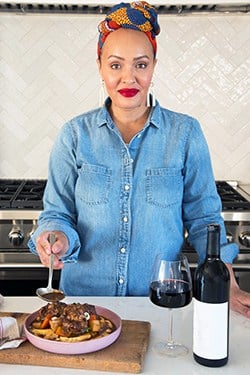
Marta I am born and raised in Puerto Rico 🇵🇷. My mother was an amazing cook but never taught us how to cook. I discovered my passion for the kitchen in my 30’s. Let me tell you that you have become my to go for any recipe that you have that is PR related and more. Thank you. Also wanted to say that this pernil reminds me of the one mi abuela used to make. Mind you I am 50+ y/o and my abuela was born in late 1800’s, again thank you.
What an honor, Julia. That means the world to me. You have no idea.
When you say roast, you mean bake or conv roast on the oven setting?
Hi, roasting is just the culinary term for cooking with heat for an extended period. You always roast using the bake setting on your oven’s temperature dial. If your oven is nice enough to have conv roast, you need to decrease the temperature by 25°F (3°C) to account for the hot air moving around in the oven. So, you can use either setting, but I recommend the bake setting since that’s how I developed the recipe.
Happy New Year!
Hi there! First I want to say I’ve been making this recipe for the last three years. Almost four. My bf is Puerto Rican and I made this for him and his family and they are obsessed lol. That being said, I’m on task to make it for Xmas eve. Now, can I buy it now and season it, wrap it and freeze it? If so what’s the rule for defrosting? I want to get it now because I’m worried there won’t be many choices by the time I go to get one. Thanks in advance and happy holidays!
If you can, wait until this weekend to buy it and try to get one that’s been packed on the day you purchase it. Check the sell/use by date and if it’s at least 2 days before Christmas, leave in the packaging. On the 21st you can marinate it and leave it in the fridge until Christmas. If you still want to freeze it, marinate and wrap it as instructed, leave it in the FRIDGE for the 3 days to marinate, then freeze it. You’ll have to pull it out on the 21st to thaw it so it thaws completely by Nochebuena. This is the reason I recommend just leaving it in the fridge and not freezing. Let me know if you have any questions.